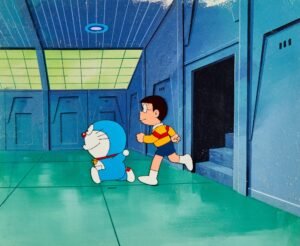The Evolution of Japanese Animation Techniques
- By -Maria Mash
- Posted on
- Posted in Animation
Japanese animation, or anime, has evolved into a globally recognized art form with a distinctive style and storytelling approach. From its humble beginnings in the early 20th century to becoming a multi-billion-dollar industry, anime has undergone significant transformations in its techniques, themes, and production methods. The evolution of Japanese animation techniques reflects broader technological advancements, cultural shifts, and the creative vision of countless artists and studios. This article explores the key stages of anime’s development, the technological breakthroughs that shaped its unique style, and the innovations that continue to define the industry.

Early Beginnings: Traditional Hand-Drawn Animation
The roots of Japanese animation can be traced back to the early 20th century, with the first known example being Namakura Gatana (1917) by Jun’ichi Kōuchi. During this period, Japanese animators were heavily influenced by Western animation, particularly from the United States and Europe. Early anime was characterized by short films that were created using traditional hand-drawn techniques, similar to those used by Western pioneers like Walt Disney.
Moreover, the early animation process involved painstaking frame-by-frame drawing and was entirely manual. Artists used cel animation, where characters were drawn on transparent sheets (cels) placed over static backgrounds. This technique allowed for some movement while keeping production costs low. Despite limited technology, early Japanese animators experimented with narrative styles and visual storytelling, laying the groundwork for the future growth of the medium.
Post-War Era and the Rise of Limited Animation
The end of World War II marked a turning point for Japanese animation. The establishment of Toei Animation in 1948 and the release of Hakujaden (The Tale of the White Serpent) in 1958, Japan’s first color animated feature film, were significant milestones. The 1960s saw the rise of “limited animation,” a technique that reduced the number of frames per second to lower production costs. This method allowed for the production of TV series, which were faster and cheaper to make compared to full animation.
In addition, the limited animation style was popularized by Osamu Tezuka, known as the “God of Manga,” who adapted his manga Astro Boy (Tetsuwan Atom) into an animated TV series in 1963. By focusing on key frames and reducing the number of in-between frames, Tezuka and his team managed to produce a series with compelling characters and narratives on a limited budget. This cost-effective approach allowed for more anime series to be produced, leading to the expansion of the medium on television and establishing anime as a staple of Japanese popular culture.
The Golden Age: Innovations in Animation Techniques
The 1980s and 1990s are often referred to as the “Golden Age” of anime. This period saw a significant increase in the quality and complexity of animation techniques, driven by technological advancements and increased investment in the industry. Studios like Studio Ghibli, founded by Hayao Miyazaki and Isao Takahata, pushed the boundaries of what anime could achieve. Films like My Neighbor Totoro (1988), Akira (1988), and Ghost in the Shell (1995) showcased intricate animation, detailed backgrounds, and complex storytelling.
Furthermore, this era saw the adoption of more sophisticated animation techniques, such as rotoscoping and multiplane camera setups, which allowed for more dynamic and layered scenes. Rotoscoping involved tracing over live-action footage to create more realistic movement, while the multiplane camera created a sense of depth by separating foreground, middle ground, and background layers. These techniques contributed to the distinctive visual style of anime during this period, making it stand out from Western animation.
The Digital Revolution: Computer Animation and CGI Integration
The late 1990s and early 2000s brought about the digital revolution, fundamentally changing anime production techniques. The shift from hand-drawn cels to digital animation allowed studios to streamline the animation process, increase efficiency, and reduce costs. Digital tools like Adobe Photoshop and After Effects became standard, enabling animators to add more detail, shading, and special effects without the constraints of traditional cel animation.
In addition, computer-generated imagery (CGI) began to be integrated into anime, allowing for more elaborate and fluid action scenes, as seen in series like Cowboy Bebop (1998) and Neon Genesis Evangelion (1995-1996). CGI also facilitated the creation of more complex mecha designs and environments in anime such as The Animatrix (2003) and Appleseed (2004). Despite initial skepticism from traditionalists, the blending of 2D and 3D animation gradually became more accepted, leading to a unique aesthetic that distinguishes anime from fully 3D animated Western films.
Hybrid Techniques and the Rise of Digital Platforms
In recent years, Japanese animation has continued to evolve by adopting hybrid techniques that combine traditional hand-drawn styles with digital tools. Productions like Demon Slayer: Kimetsu no Yaiba (2019) and Attack on Titan (2013-present) have demonstrated how seamless integration of CGI and digital effects can enhance the visual experience without losing the essence of 2D animation. These series utilize digital techniques for dynamic camera movements, lighting, and particle effects, which add to the cinematic quality of anime.
Furthermore, the rise of digital platforms like Netflix, Crunchyroll, and Amazon Prime Video has expanded anime’s global reach, influencing both the production process and storytelling approaches. Animators now have more resources and opportunities to experiment with new techniques, such as motion capture and virtual reality, to create immersive experiences. This evolution has led to the production of anime that is more varied in style and genre, catering to a broader international audience.
Pushing Boundaries: Experimental and Avant-Garde Techniques
Japanese animation has also seen a surge in experimental and avant-garde techniques in recent years, challenging conventional animation norms. Directors like Masaaki Yuasa (Devilman Crybaby [2018], Mind Game [2004]) and Makoto Shinkai (Your Name [2016], Weathering with You [2019]) are known for their innovative approaches to animation. Yuasa, for example, often employs a fluid, almost surreal animation style that breaks away from traditional anime aesthetics, while Shinkai’s work is characterized by hyper-realistic backgrounds combined with fantastical elements.
In addition, anime shorts and independent films have become platforms for pushing the boundaries of animation. Projects like The Animatrix (2003) and Genius Party (2007) showcase the creativity of Japanese animators by experimenting with different visual styles, narratives, and techniques. These works reflect the versatility of anime as a medium that can accommodate both mainstream and avant-garde sensibilities, continually redefining what animation can achieve.
Conclusion
In summary, the evolution of Japanese animation techniques reflects a continuous journey of innovation, adaptation, and creative exploration. From the early days of hand-drawn animation to the digital revolution and beyond, anime has grown into a dynamic and diverse art form that captivates audiences worldwide. The integration of traditional and modern techniques, along with the willingness to experiment, ensures that Japanese animation remains at the forefront of the global animation industry. As technology continues to advance and new generations of animators bring fresh perspectives, the future of anime promises to be as bold and imaginative as its past.



